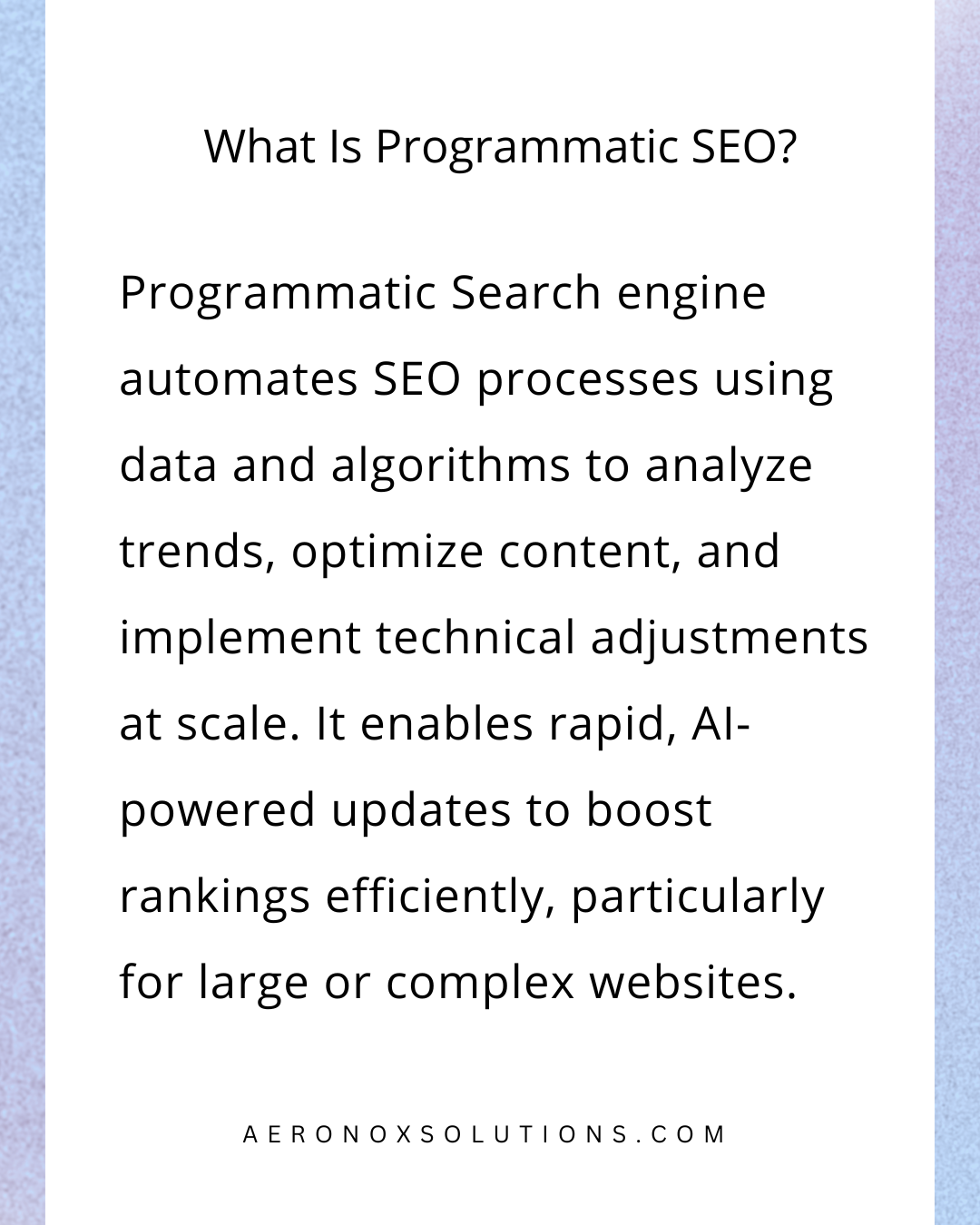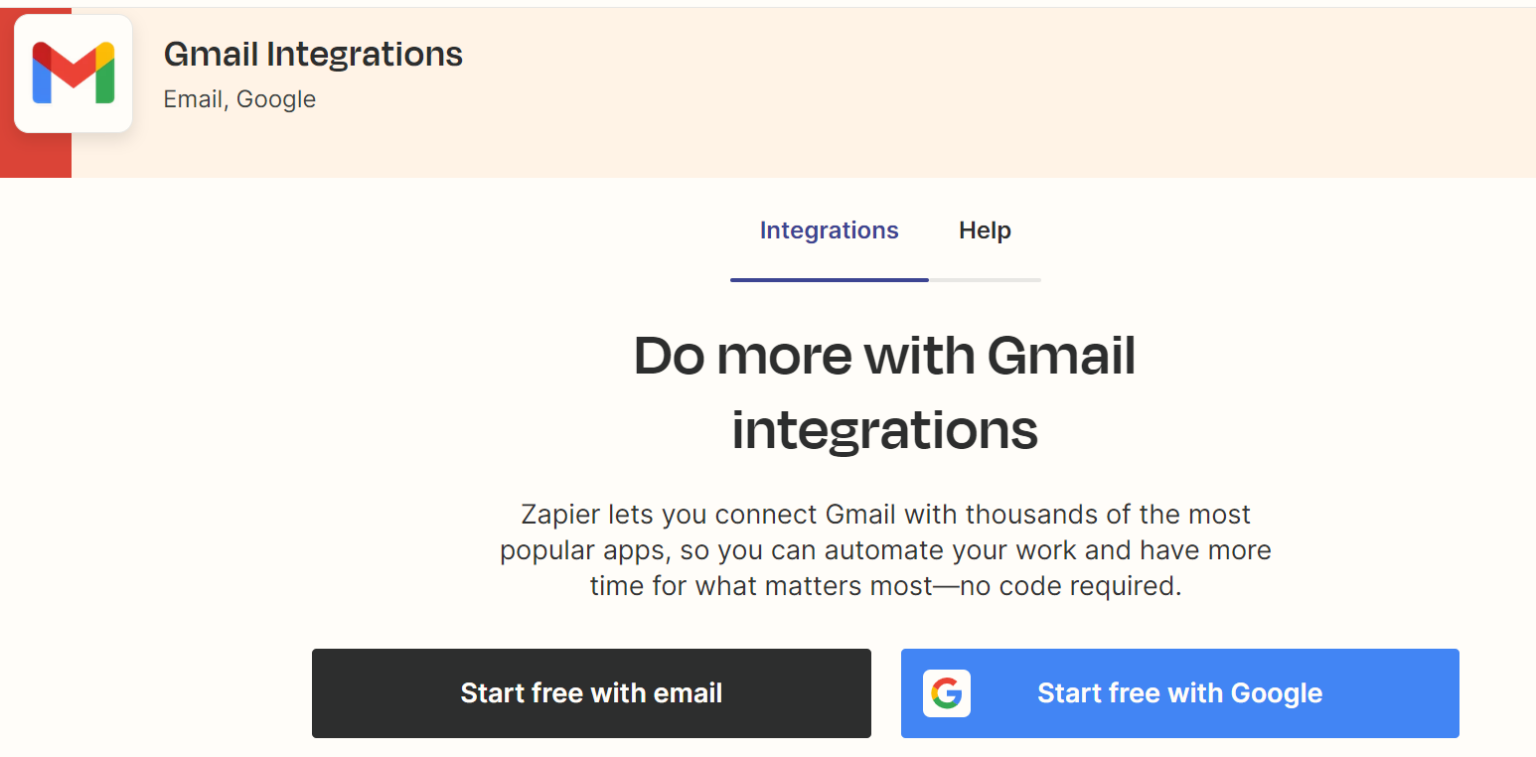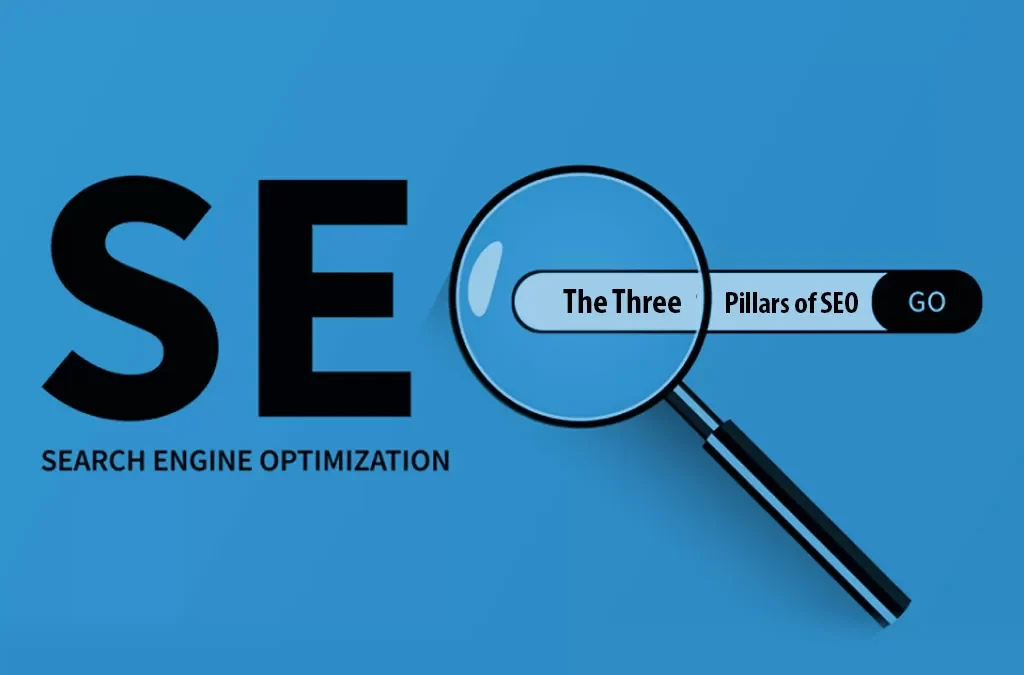
Manual SEO tactics once the gold standard now struggle to compete with the sheer volume of data, the complexity of trends, and the demand for instant, scalable results. A programmatic SEO: a game-changing approach that merges automation, artificial intelligence, and big data to transform how businesses optimize for search.
By leveraging tools that analyze millions of data points in seconds, programmatic SEO uncovers hidden opportunities, automates repetitive tasks, and delivers hyper-targeted optimizations at scale. It’s not just about working harder, it’s about working smarter, faster, and with surgical precision.
But how do you transition from traditional methods to this cutting-edge strategy? Let’s break down the steps to implement programmatic SEO and future-proof your digital presence.
Key Points To Consider:
- What is Programmatic SEO?
- What are the advantages and disadvantages of the Programmatic SEO?
- How to do programmatic SEO? 6 Steps guide to Follow
- Three Pillars of Programmatic SEO
- Difference Between Programmatic SEO and Regular SEO?
What is Programmatic SEO?
Programmatic SEO is like having a robot assistant turbocharge your website’s search rankings. It uses smart tech and AI to:
- Scan millions of data points (like keywords, competitors, and trends)
- Auto-optimize content, meta tags, or site structure in real-time
- Scale SEO efforts across thousands of pages effortlessly
Instead of manual tweaks, it’s fast, data-powered, and adaptive constantly adjusting to Google’s updates and user behavior. Think of it as SEO on autopilot, built for massive sites that need to rank smarter, not harder.
Zapier has more than 800K programmatic landing pages that follow the same template. Here’s an example:


Zapier has these landing pages for all the apps that it supports and these all pages have the same template and style.
What are the advantages and disadvantages of the Programmatic SEO?
Like any content marketing strategy, programmatic SEO has its advantages and disadvantages. Let’s take a closer look:
Pros
- Targets long-tail keywords and ultra-specific search queries effortlessly.
- Boosts organic traffic by scaling content across thousands of pages.
- Generates unique content quickly (e.g., product descriptions, location pages).
- Saves costs vs. manual writing, especially for large sites.
Cons
- Technical complexity (requires tools like Python, SEO APIs, or enterprise platforms).
- Duplicate content risks if automation rules aren’t finely tuned.
- Keyword cannibalization can hurt rankings if pages overlap topics.
- Constant maintenance needed to adapt to SEO trends and data changes.
How to do programmatic SEO? 7 Steps guide to Follow
Implementing programmatic SEO involves a strategic approach that combines keyword research, content creation, and technical optimization. Here are some key steps to follow:
Step 1: Identify Your Target Audience & Search Intent

The foundation of successful programmatic SEO lies in deeply understanding who your audience is and why they’re searching. Without this clarity, even the most scalable content strategy can fall flat.
Start by painting a clear picture of your ideal visitor. Are they professionals seeking industry insights? Parents looking for quick solutions? Tech enthusiasts comparing gadgets? Use analytics tools like Google Analytics or social media insights to gather demographic and behavioral data.
For example, a SaaS company might target “startup founders needing affordable CRM tools,” while a cooking site might focus on “busy parents looking for 30-minute meals.”
Google categorizes searches into four main intent types, and your content must align with them:
- Informational – The user wants answers (e.g., “How to unclog a sink”).
- Navigational – The user is looking for a specific brand or site (e.g., “Netflix login”).
- Commercial – The user is researching before buying (e.g., “Best wireless earbuds 2024”).
- Transactional – The user is ready to purchase (e.g., “Buy AirPods Pro”).
To uncover intent, study Google’s top results for your target keywords. If the top pages are all “how-to” guides, Google sees the intent as informational so a sales page won’t rank well. Tools like AnswerThePublic or SEMrush’s Keyword Magic Tool can reveal question-based queries, while Google’s “People Also Ask” section highlights related searches.
Imagine you run a travel website. Research might show:
- Informational intent: “Best time to visit Bali” (needs a detailed guide).
- Commercial intent: “Bali family resorts with kids’ clubs” (needs comparison content).
- Transactional intent: “Book Conrad Bali hotel” (needs a booking page).
By aligning your programmatic pages with the right intent, you ensure they rank and convert.
At last, skipping audience and intent research leads to generic content that doesn’t rank no matter how well-optimized. Programmatic SEO scales what works, so start with a solid foundation.

Step 2: Conduct Keyword Research for Scalable, Low-Competition Opportunities
Keyword research is the fuel that powers programmatic SEO. Unlike traditional SEO, where you might target a handful of competitive terms, programmatic SEO thrives on identifying hundreds (or thousands) of long-tail, low-competition keywords that can be systematically targeted through automated content.
Why Long-Tail Keywords Work Best for Programmatic SEO
- Lower competition: Easier to rank for compared to broad terms.
- Higher intent: Searchers are closer to taking action (e.g., “buy” vs. “best”).
- Scalability: Perfect for generating large volumes of targeted pages.
How to Find the Right Low Competition Keywords?
Begin with broad topics relevant to your business (e.g., “yoga mats,” “CRM software,” “vegan recipes”). Use these as a foundation to uncover more specific variations.

Leverage tools like:
- Ahrefs / SEMrush: For competition analysis and keyword suggestions.
- AnswerThePublic / AlsoAsked.com: To find question-based queries.
- Google Keyword Planner: For search volume and trends.
- Google Autocomplete: Type your seed keyword into Google and note the suggestions.
If your seed keyword is “yoga mats,” tools might reveal long-tail variations like:
- “best non-slip yoga mats for hot yoga”
- “thickest yoga mat for bad knees”
- “eco-friendly yoga mats under $50”
Look for low competition keywords with:
- Low Keyword Difficulty (KD): Aim for < 30 in Ahrefs/SEMrush.
- Decent Search Volume: 50-1,000 monthly searches (higher isn’t always better).
- Commercial or Informational Intent: Match the intent to your content strategy.
Organize keywords into themes to create structured content templates later.
Example Cluster for “Yoga Mats”:
- Performance: “best yoga mats for grip,” “non-toxic yoga mats”
- Budget: “cheap yoga mats under $20,” “affordable yoga mats”
- Specialty: “yoga mats for tall people,” “travel yoga mats”
Once you’ve compiled a massive list of long-tail keywords, the next phase is structuring them into a content plan so they can be turned into scalable templates.
Pro Tip: Export keywords into a spreadsheet and tag them by intent, difficulty, and potential template type for easy scaling later.
Step 3: Build a Content Plan & Scalable Templates
With a solid keyword list in hand, the next step is transforming those terms into a systematic content plan, one that aligns with search intent and can be automated at scale. This is where programmatic SEO shifts from theory to execution.
First, categorize your keywords by intent and content type. For example:
- Informational queries (e.g., “how to clean a yoga mat”) → Guide articles
- Commercial queries (e.g., “best eco-friendly yoga mats”) → Comparison pages
- Transactional queries (e.g., “buy cork yoga mat”) → Product pages
This ensures each page serves a clear purpose, matching what users (and Google) expect.
Programmatic SEO relies on templates pre-designed page structures that dynamically populate with unique data. Here’s how to approach them:
Every template should include:
-
- A title optimized for the keyword (e.g., “Best Yoga Mats for Sweaty Hands [2024]”)
- An introduction addressing search intent
- A main content section (comparison tables, FAQs, step-by-step guides)
- A conclusion or CTA (e.g., “Where to Buy”)
Insert variables that auto-fill based on your database. For example:
-
- “{{Product}} is ideal for {{Audience}} because {{Unique Benefit}}.”
- “{{City}}’s top-rated {{Service}} includes {{Feature}} and {{Feature}}.”
-
- Include schema markup (for rich snippets)
- Structure with H2/H3 headers for easy scanning
- Keep paragraphs short and scannable
Templates need data to work. The next phase is building a structured database, whether it’s product specs, location details, or expert tips—to feed into your templates.
Pro Tip: Test templates on 5-10 pages first. Tweak based on rankings before full rollout.
Step 4: Build a Structured Database for Scalable Content
Programmatic SEO lives and dies by the quality of its data. A well-structured database acts as the backbone of your automated content without it, your pages risk being generic, shallow, or worse, flagged as low-value by search engines.
The goal is to create a centralized, organized repository of unique information that your templates can dynamically pull from to generate high-quality pages at scale.
Your database should be more than just a spreadsheet it needs to capture the nuances that make content authoritative and useful. For example, if you’re building a programmatic SEO strategy for a fitness site, your database shouldn’t just list exercise names. It should include:
- Detailed descriptions of each movement (e.g., “The deadlift targets the posterior chain, including hamstrings and glutes, while improving grip strength”)
- Variations (e.g., “Romanian deadlift vs. conventional deadlift”)
- Common mistakes (e.g., “Rounding the back during execution”)
- Equipment alternatives (e.g., “Can substitute barbell with kettlebells”)
This depth transforms robotic content into genuinely helpful resources that stand out in search results.
The most effective databases combine multiple sources:
- Primary Research
Conduct original testing, interviews, or surveys. If you’re creating product comparison pages, actually use the products and document your findings. This could be as simple as a “lab test” section in your database noting “Yoga Mat A retained grip after 100 sweat sessions, while Mat B peeled after 30.” - Aggregated Data
Pull from reputable sources like academic studies, manufacturer specs, or industry reports. For local business pages, scrape Google My Business for updated hours/services, then enhance with your own commentary like “This dentist is one of only 12 in Chicago offering Saturday emergency services.” - User-Generated Content
Incorporate moderated reviews, forum discussions (Reddit, Quora), or social sentiment. A parenting site might track real mom complaints about strollers like “Wheel durability issues reported in 22% of Amazon reviews.
With your database polished, you’re ready to connect it to your CMS and unleash scalable content creation. The key is setting up systems where updates to your database automatically propagate across all relevant pages, keeping your site perpetually fresh.
Pro Tip: Start with a pilot automate just 10-20 pages first. Monitor rankings and user engagement before scaling to thousands.
READ MORE: How do I See Competitors Google Ads?
Step 5: Integrate Your Database & Automate Page Creation
With your structured database ready, the next critical phase is connecting it to your content management system (CMS) and automating page generation. This step transforms raw data into live, SEO-optimized pages at scale eliminating manual work while maintaining quality.
The method you select depends on your technical resources and website platform. For WordPress users, plugins like Advanced Custom Fields (ACF) or JetEngine allow dynamic field mapping where spreadsheet data automatically populates page templates. Those using Shopify can leverage metafields combined with Liquid templating to generate unique product variations.
Automation requires ongoing oversight. Implement monitoring to catch template errors or data inconsistencies like sudden traffic drops in Google Search Console indicating misaligned pages. Schedule monthly database audits to update outdated information, and build alerts for failed automation jobs. For high-stakes websites, a manual review queue for newly generated pages adds quality control.
With pages now generating automatically, shift focus to refining their performance. The coming step covers on-page SEO tweaks, user experience enhancements, and the analytics setup needed to track success at scale.
Pro Tip: Run A/B tests on different template layouts sometimes a simple H2 structure change can double engagement.
Step 6: Optimize Programmatic Pages for Search Engines and User Experience
Automated page generation is only half the battle, without careful optimization, your programmatic SEO pages may fail to rank or deliver a poor experience. This step ensures your scaled content meets both Google’s requirements and user expectations.
Every programmatic page must be structured for search engines. Start with keyword-optimized titles and meta descriptions, keeping them concise (under 60 characters for titles, 160 for meta descriptions) while naturally incorporating the primary keyword. For example, instead of a generic “Running Shoes Review,” opt for “Best Cushioned Running Shoes for Long Distances (2024).”
Headers should follow a logical hierarchy H1 for the main title, H2s for core sections like “Top Picks” or “Key Features,” and H3s for deeper subsections such as “Durability Test Results” or “User Feedback Analysis.” This not only helps search engines understand your content but also improves readability.
To avoid sounding robotic, enrich your content with semantic variations of your target keyword. Tools like Google’s “People Also Ask” analyzers can help identify related terms. For instance, if your page targets “best hiking boots,” include terms like “waterproof hiking gear” or “ankle support for trails” to provide context.
One of the biggest risks with programmatic SEO is generating thin or duplicate content. For example, a page on “Best Laptops for Graphic Design” could include real performance benchmarks like “The Dell XPS 15 rendered 4K video 22% faster than competitors in our tests.”
If your content relies on product specs or data points, rewrite them in natural language. Instead of listing “Battery: 5000mAh,” phrase it as “The 5000mAh battery lasts through a full day of heavy use, based on our stress tests.” This approach keeps the content valuable and engaging.
Beyond the content itself, technical optimizations are critical. Ensure all pages have clean, descriptive URLs (e.g., /best-running-shoes-for-flat-feet instead of /product?id=123). Optimize images by compressing file sizes and using alt text that includes keywords where relevant (e.g., “Brooks Ghost 15 running shoe side profile”).
Internal linking is another powerful tool. Programmatically link related pages—for example, a “Best Hiking Boots” page should link to “How to Waterproof Hiking Gear” if it’s relevant. This strengthens site architecture and keeps users engaged.
Mobile-friendliness and page speed are non-negotiable. Use Google’s Lighthouse tool to audit performance, and fix issues like unoptimized images or render-blocking JavaScript. A slow-loading page will lose rankings and visitors.
After launch, track performance using Google Search Console and analytics tools. Look for pages with high impressions but low clicks this suggests your title or meta description needs tweaking. Similarly, high bounce rates may indicate poor content quality or mismatched search intent.
Set up alerts for sudden ranking drops, which could signal algorithmic penalties or technical errors. Regularly update your templates based on performance data—for example, if pages with comparison tables outperform listicles, adjust future content accordingly.
With your pages live and optimized, the final phase is ongoing refinement. Track rankings, user behavior, and conversions to ensure your programmatic SEO strategy delivers sustainable growth.
Pro Tip: Run A/B tests on different template layouts sometimes small changes, like adding a “Quick Takeaways” section, can significantly boost engagement.
READ MORE: Do Breadcrumbs Improve SEO?
Three Pillars of Programmatic SEO

To build a successful programmatic SEO strategy, you need more than just automation you need a foundation that ensures your content ranks, engages, and converts. That foundation rests on three core principles:
1. Target Low-Competition Keywords
Programmatic SEO works best when you focus on long-tail, low-competition keywords the specific, often overlooked search queries that larger websites ignore. Instead of battling for broad terms like “best laptops,” aim for precise searches like “best lightweight laptop for graphic design under $1500.” These keywords are easier to rank for, attract more qualified traffic, and allow you to scale content efficiently.
To find them, use tools like Ahrefs or SEMrush to filter for keywords with moderate search volume (50–1,000 monthly searches) and low difficulty scores (under 30). Look for gaps where top-ranking pages are weak—thin content, outdated information, or poor user experience so you can create something better.
2. Match Search Intent Precisely
Google ranks pages based on how well they answer the searcher’s underlying need. If your content doesn’t align with what users actually want, it won’t rank—no matter how well-optimized it is. There are four main types of search intent:
- Informational (e.g., “how to fix a slow laptop”) → Answer with guides, tutorials, or FAQs.
- Commercial (e.g., “best wireless earbuds for running”) → Provide comparisons, reviews, or buyer’s guides.
- Transactional (e.g., “buy Sony WH-1000XM5 headphones”) → Optimize product pages with clear CTAs.
- Navigational (e.g., “Apple AirPods Pro official site”) → Direct users to brand or service pages.
Before creating a page, study the top-ranking results. If Google favors listicles, your template should follow that format. If videos dominate, consider embedding them.
3. Prioritize User Experience (UX)
Even the most well-optimized programmatic pages will fail if they feel robotic or hard to use. To keep visitors engaged:
- Write naturally—avoid repetitive keyword stuffing by varying phrasing and adding unique insights.
- Structure content for readability—use clear headings, short paragraphs, and visual elements like tables or images.
- Optimize for speed and mobile—slow-loading or poorly formatted pages increase bounce rates.
- Add internal links—guide users to related content to improve dwell time and site authority.
For example, a programmatic page on “best office chairs for back pain” should include:
- A comparison table highlighting key features (lumbar support, adjustability, etc.).
- Real user reviews or expert opinions.
- Links to related guides like “how to improve posture at work.”
Low-competition keywords give you a foothold in search results. Aligning with search intent ensures Google sees your pages as relevant. Strong UX keeps visitors engaged, signaling quality to search algorithms.
The result? A scalable, high-performing content engine that grows organically without manual grunt work.
Difference Between Programmatic SEO and Regular SEO

| Aspect | Programmatic SEO | Regular SEO | Example |
|---|---|---|---|
| Approach | Uses automation, templates, and databases to generate pages at scale. | Manually creates and optimizes individual pages. | Programmatic: Auto-generating 1,000 city-specific “best dentists” pages. Regular: Writing a detailed “Best Dentists in NYC” guide. |
| Scalability | Designed for large-scale content production (hundreds/thousands of pages). | Focuses on high-quality, manually crafted pages (e.g., blog posts, service pages). | Programmatic: A travel site generates automated “hotels in [city]” pages for 500 locations. Regular: A boutique agency writes a “Top 10 Luxury Hotels in Bali” article. |
| Keyword Targeting | Systematically targets long-tail, low-competition keywords. | Mixes head terms and long-tail keywords with manual research. | Programmatic: “Best running shoes for flat feet in [city].” Regular: “How to Choose Running Shoes.” |
| Content Creation | Templates dynamically populate data (e.g., prices, locations, specs). | Custom-written content with human insights. | Programmatic: Auto-filled product pages with data from a CSV. Regular: A detailed “iPhone 15 Review” based on hands-on testing. |
| Technical Requirements | Requires databases, APIs, and developer/CMS integrations. | Uses standard SEO plugins (Yoast, RankMath) and manual edits. | Programmatic: Using Python to scrape and upload data to WordPress. Regular: Manually editing meta tags via RankMath. |
| Flexibility | Less flexible post-launch (requires template/database updates for changes). | Highly adaptable (content can be tweaked anytime). | Programmatic: Updating 1,000 pages by modifying a template. Regular: Editing a sentence in a blog post in seconds. |
| Best For | Large sites with repetitive content needs (e-commerce, directories, local SEO). | Small-to-medium sites prioritizing authority, storytelling, and unique insights. | Programmatic: Zillow’s property pages. Regular: HubSpot’s marketing blog. |
| Risks | Can lead to thin or duplicate content if not properly managed. | Time-consuming and harder to scale. | Programmatic: 50 near-identical service pages getting penalized by Google. Regular: A single outdated guide losing traffic. |
Programmatic SEO = Scale + Automation (Best for data-driven, repetitive content).
Regular SEO = Precision + Human Touch (Best for thought leadership and niche sites).
Programmatic SEO isn’t about flooding the web with generic pages. It’s about strategically dominating niche searches with content that’s both data-driven and user-friendly. Master three pillars, and your automated pages will outperform even manually crafted competitors.



